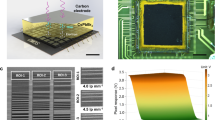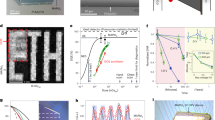Abstract
Sensitive and stable defect tolerant detectors with a long life, operating at low bias are essential for portable medical and security applications. Low-cost Polymer-high Z composite with conductive fillers show enhanced charge transportation and better long-term stability compared to conventional direct X-ray detector materials. Here, we report Polystyrene-Bismuth triiodide composite with carbon black incorporated as conductive filler. The composite showed great tolerance towards radiation induced structural damage as confirmed with XRD studies of pre and post irradiated samples. Also, the radiation induced defects in the composite due to continuous irradiation of X-rays have been studied with variation in thickness. In traditional planar detector configuration, photon absorption efficiency is defined by the thickness of the material, however as a downside, it limits the charge transport properties affected by traps in the chosen material. Therefore, a trade-off must be found between photon absorption efficiency and charge collection efficiency The detector shows low dark current density of 0.5 nA/cm2 and high sensitivity of 0.6 × 103 µC/Gy-cm3 against dose rate of 500 µ-Gy/sec. at 30 V bias. In addition, the stability test exhibits no deterioration in sensing for integrated dose of 3200 mGy in one run which is 32,000 times the dose used in chest X-rays. In addition, the sample fully recovers its charge collection ability and neutralizes the space charge accumulation due to continuous irradiation illustrating longevity of the sample. The composite shows intriguing results as a promising material for low-bias, portable detector with high stability for X-ray imaging and detection applications.





Similar content being viewed by others
Data availability
Data sets generated during the current study are available from the corresponding author on reasonable request.
References
M.J. Yaffe, J.A. Rowlands, X-ray detectors for digital radiography. Phys. Med. Biol. 42, 1 (1997)
A. Datta, Z. Zhong, S. Motakef, A new generation of direct X-ray detectors for medical and synchrotron imaging applications. Sci. Rep. 10, 20097 (2020)
J. Seco, B. Clasie, M. Partridge, Review on the characteristics of radiation detectors for dosimetry and imaging. Phys. Med. Biol. 59, R303 (2014)
Z. Li, F. Zhou, H.H. Yao, Z. Ci, Z. Yang, Z. Jin, Halide perovskites for high-performance X-ray detector. Mater. Today 48, 155 (2021)
R. Chaudhari, C.R. Kant, A. Garg, Polymer-BiI3 composites for high-performance, room-temperature direct X-ray detectors. MRS Commun 12(3), 358–364 (2022)
S. Feizi, A. Mehdizadeh, M.A. Hosseini, S.A. Jafari, P. Ashtari, Reduced graphene oxide/polymethyl methacrylate (rGO/PMMA) nanocomposite for real time gamma radiation detection. Nucl. Instr. Methods Phys. Res. Sect. A 940, 72 (2019)
C.V. More, Z. Alsayed, M.S. Badawi, A.A. Thabet, P.P. Pawar, Polymeric Composite Materials for Radiation Shielding: A Review, vol. 19 (Springer International Publishing, New York, 2021)
R. Chaudhari, A. Garg, K. Singh, M. Tomar, V. Gupta, C. RaviKant, Bismuth tri-iodide-polystyrene composite for X-rays switching applications at room temperature. Radiat. Phys. Chem. 186, 109538 (2021)
H.M. Thirimanne et al., High sensitivity organic inorganic hybrid X-ray detectors with direct transduction and broadband response. Nat. Commun. 9(1), 2926 (2018)
Y.S. Zhao, Z. Yu, A. Douraghy, A.F. Chatziioannou, A facile route to bulk high-Z polymer composites for gamma ray scintillation. Chem. Commun. (Camb.) (2008). https://doi.org/10.1039/b813571a
J. Peng, K. Ye, Y. Xu, L. Cui, R. Li, H. Peng, Q. Lin, X-ray detection based on crushed perovskite crystal/polymer composites. Sens. Actuators. A Phys. 312, 112–132 (2020)
A. Intaniwet, C.A. Mills, M. Shkunov, H. Thiem, J.L. Keddie, P.J. Sellin, Characterization of thick film poly(triarylamine) semiconductor diodes for direct X-ray detection. J. Appl. Phys. 106, 1 (2009)
Z. Gou, S. Huanglong, W. Ke, H. Sun, H. Tian, X. Gao, X. Zhu, D. Yang, P. Wangyang, Self-powered X-ray detector based on all-inorganic perovskite thick film with high sensitivity under low dose rate. Phys. Status Solidi - Rapid Res. Lett. 13, 1 (2019)
X. Gao, H. Sun, D. Yang, P. Wangyang, C. Zhang, X. Zhu, Large-area CdZnTe thick film based array X-ray detector. Vacuum 183, 109855 (2021)
W. Pan et al., Cs2AgBiBr6 single-crystal X-ray detectors with a low detection limit. Nat. Photonics 11, 726 (2017)
H. Li, J. Song, W. Pan, D. Xu, W. Zhu, H. Wei, B. Yang, Sensitive and stable 2D Perovskite single-crystal X‐ray detectors enabled by a supramolecular anchor. Adv. Mater. 32, 2003790 (2020)
M.Z. Kabir, S.O. Kasap, Charge Transport and Trapping-Limited Sensitivity and Resolution of Pixellated X-Ray Image Detectors, in edited by M. J. Yaffe and L. E. Antonuk (2003), p. 26
S.O. Kasap, X-ray sensitivity of photoconductors: application to stabilized a-Se. J. Phys. D Appl. Phys. 33, 2853 (2000)
L. Basiricò et al., Medical applications of tissue-equivalent, organic-based flexible direct X-ray detectors. Front. Phys. 8, 1 (2020)
M. Girolami, M. Bosi, V. Serpente, M. Mastellone, L. Seravalli, S. Pettinato, S. Salvatori, D.M. Trucchi, R. Fornari, Orthorhombic undoped κ-Ga2O3 epitaxial thin films for sensitive, fast, and stable direct X-ray detectors. J. Mater. Chem. C 11, 3759 (2023)
W. Liu et al., PbI2-DMSO assisted in situ growth of perovskite wafers for sensitive direct X-ray detection. Adv. Sci. 10, 1 (2023)
Y. Li, H. Chen, Z. Hao, Z. Li, X. Wu, X. Li, J. Zhang, Direct X-ray detectors based on pdms films with low detection limit and high flexibility. IEEE Electron. Device Lett. 43, 1997 (2022)
X. Zheng, W. Zhao, P. Wang, H. Tan, M.I. Saidaminov, S. Tie, L. Chen, Y. Peng, J. Long, W.H. Zhang, Ultrasensitive and stable X-ray detection using zero-dimensional lead-free perovskites. J. Energy Chem. 49, 299 (2020)
M.-J. Xie, J. Lu, B.-Y. Li, W.-F. Wang, S.-H. Wang, F.-K. Zheng, G.-C. Guo, Barium(II)-based semiconductive coordination polymers for high-performance direct X-ray detection and imaging: reducing the exciton binding energy via enhancing π-π interactions. Chem. Eng. J. 466, 143272 (2023)
R. Chaudhari, C. RaviKant, A Review on BiI3 Perovskites and Composites for Direct X-Ray Detection. Sens Actuator A: Physical. 346, 1138 (2022)
R. Chaudhari, S. Kumar Sharma, C. Ravi Kant, A. Garg, Investigations on low energy X-ray induced strong radiation matter interaction phenomena in polymer-BiI3 hybrid materials for room temperature radiation detectors. Mater. Today Proc. 67, 478 (2022)
J.Y.Y. Loh, N.P. Kherani, X-ray photospectroscopy and electronic studies of reactor parameters on photocatalytic hydrogenation of carbon dioxide by defect-laden indium oxide hydroxide nanorods. Molecules 24, 1 (2019)
P. Dey, V. Khorwal, P. Sen, Spectral studies of lead-free organic-inorganic hybrid solid-state spectral studies of lead-free organic-inorganic hybrid potential photo absorbers. Chem. Support. 3(2), 794–800 (2018)
J. Hou, K. Jian, M. Shen, R. Wei, X. Wu, F. Idrees, C. Cao, Micro and nano hierachical structures of BiOI/Activated carbon for efficient visible-light-photocatalytic reactions. Sci. Rep. 7(1), 11665 (2017)
H.A. Thabit, N.A. Kabir, The study of X-ray effect on structural, morphology and optical properties of ZnO Nanopowder. Nucl. Instr. Method. Phys. Res. Sect. B Beam Interact. with Mater. Atoms 436, 278 (2018)
J. Alarcón, S. Ponce, F. Paraguay-Delgado, J. Rodríguez, Effect of γ-irradiation on the growth of ZnO nanorod films for photocatalytic disinfection of contaminated water. J. Coll. Interfac. Sci. 364, 49 (2011)
S. Iqbal, M.S. Rafique, S. Anjum, A. Hayat, N. Iqbal, Impact of X-ray irradiation on PMMA thin films. Appl. Surf. Sci. 259, 853 (2012)
W. Qian, X. Xu, J. Wang, Y. Xu, J. Chen, Y. Ge, J. Chen, S. Xiao, S. Yang, An aerosol-liquid-solid process for the general synthesis of halide perovskite thick films for direct-conversion X-ray detectors. Matter 4, 942 (2021)
Z. Deng, F. Wei, Y. Wu, R. Seshadri, A.K. Cheetham, P. Canepa, Understanding the structural and electronic properties of bismuth trihalides and related compounds. Inorg. Chem. 59, 3377–3386 (2020)
B. Xin, N. Alaal, S. Mitra, A. Subahi, Y. Pak, D. Almalawi, N. Alwadai, S. Lopatin, I.S. Roqan, Identifying carrier behavior in ultrathin indirect-bandgap CsPbX3 nanocrystal films for use in UV/Visible‐blind high‐energy detectors. Small 16, 2004513 (2020)
Q. Xu, B. Zhang, J. Nie, H. Zhang, X. Ouyang, J. Liu, Y. Liu, Self-powered X-ray detector based on methylammonium lead tribromide single crystals. J. Alloys Compd. 859, 157826 (2021)
B. Fraboni, A. Ciavatti, F. Merlo, L. Pasquini, A. Cavallini, A. Quaranta, A. Bonfiglio, A. Fraleoni-Morgera, Organic semiconducting single crystals as next generation of low-cost, room-temperature electrical X-ray detectors. Adv. Mater. 24, 2289 (2012)
N.S. Edwards, D.S. McGregor, 2014 IEEE Nuclear Science Symposium and Medical Imaging Conference (NSS/MIC) (IEEE, 2014), pp. 1–4
M. Xia et al., Unveiling the structural descriptor of A3B2X9 perovskite derivatives toward X-ray detectors with low detection limit and high stability. Adv. Funct. Mater. 30, 2 (2020)
D. Xin, S. Dong, M. Zhang, S. Tie, J. Ren, L. Lei, P. Yu, J. Zhu, Y. Zhao, X. Zheng, Nucleation engineering in sprayed MA3Bi2I9 films for direct-conversion X-ray detectors. J. Phys. Chem. Lett. 13, 371 (2022)
M. McPherson, Charge collection degradation in relaxation semiconductor detectors fabricated from silicon. Radiat. Eff. Defects Solids 159, 45 (2004)
Acknowledgements
Ritu Chaudhari acknowledges Indira Gandhi Delhi Technical University for Women for university Junior and senior Research Fellowship and various infrastructure and facilities for research.
Author information
Authors and Affiliations
Contributions
All authors contributed to the study conception and design. Material preparation, data collection and analysis were performed by RC and CRK. The first draft of the manuscript was written by RC and CRK commented on previous versions of the manuscript. All authors read and approved the final manuscript.
Corresponding author
Ethics declarations
Competing interest
The authors declare that they have no known competing financial interests or personal relationships that could have appeared to influence the work reported in this paper.
Additional information
Publisher’s Note
Springer Nature remains neutral with regard to jurisdictional claims in published maps and institutional affiliations.
Rights and permissions
Springer Nature or its licensor (e.g. a society or other partner) holds exclusive rights to this article under a publishing agreement with the author(s) or other rightsholder(s); author self-archiving of the accepted manuscript version of this article is solely governed by the terms of such publishing agreement and applicable law.
About this article
Cite this article
Chaudhari, R., Ravikant, C. Highly stable and sensitive polystyrene/carbon black-BiI3 composite for direct X-ray detector. J Mater Sci: Mater Electron 34, 1687 (2023). https://doi.org/10.1007/s10854-023-11106-1
Received:
Accepted:
Published:
DOI: https://doi.org/10.1007/s10854-023-11106-1




